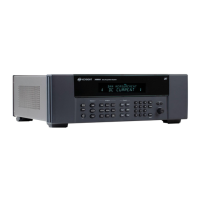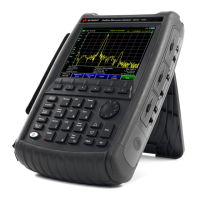Power Meter Remote Operation 1
Keysight N8262A Programming Guide 81
– <string>,<type>,<size>
The <string>, <type> and <size> are all character data. The <type> is always
TABL. The <size> is displayed in bytes.
For example, a sample of the response may look like:
560,8020,“Offset_1,TABL,220”,”Offset_2,TABL,340” ....
Naming Frequency Dependent Offset Tables
To rename a frequency dependent offset table use:
MEMory:TABLe:MOVE <string>,<string>
The first <string> parameter identifies the existing table name, and the second
identifies the new table name.
The following rules apply to frequency dependent offset table names:
1 Table names use a maximum of 12 characters.
2 All characters must be upper or lower case alphabetic characters, or numeric
(0-9), or an underscore (_).
No spaces are allowed in the name.
Reviewing Table Data
To review the data stored in a frequency dependent offset table, use the following
commands:
MEMory:TABLe:SELect "Offset1"
Select the sensor calibration table named “Offset1”.
MEMory:TABLe:SELect?
Query command which returns the name of the currently selected table.
MEMory:TABLe:FREQuency:POINTs?
Query command which returns the number of stored frequency points.
MEMory:TABLe:FREQuency?
Query command which returns the frequencies stored in the frequency dependent
offset table (in Hz).
MEMory:TABLe:GAIN[:MAGNitude]:POINTs?
Query command which returns the number of offset factor points stored in the
frequency dependent offset table.
MEMory:TABLe:GAIN[:MAGNitude]?
Query command which returns the offset factors stored in the frequency
dependent offset table.
